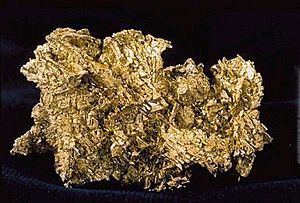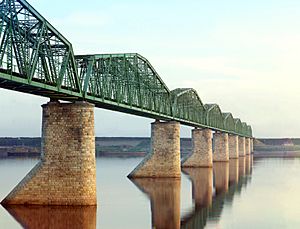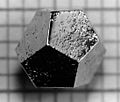Metal facts for kids
Metals are a special group of chemical elements. They make up most of the elements you can find on the periodic table. Metals usually have some cool features:
- They can carry electricity and heat very well.
- You can easily shape them.
- They often look shiny.
- They need a lot of heat to melt.
Most metals are solid when it's room temperature. But not all! For example, mercury is a liquid metal. When you mix a metal with other metals or even non-metals, you get something called an alloy. Some common metals are aluminium, copper, iron, gold, and silver. Famous alloys include bronze and steel.
The study of metals is called metallurgy.
Contents
What Makes Metals Special?
Most metals are strong and shiny. They also feel heavy. You need to heat them to very high temperatures to make them melt. If you hit a piece of metal, it often makes a bell-like sound. This means it is sonorous.
Heat and electricity can travel through metal easily. This is called being conductive. You can hammer a piece of metal into a thin sheet. This property is called malleable. You can also pull it into thin wires, which means it is ductile. Metals are hard to pull apart or smash. This is because they have high tensile strength and compressive strength. If you push on a long, thin metal piece, it will bend instead of breaking. This is called being elastic.
Not all metals have all these features. For example, lead is very soft. Also, iron doesn't carry heat and electricity as well as copper does.
How We Use Metals
Metals are super useful for people. We use them to make tools because they are strong and easy to shape. Iron and steel have been used to build bridges, buildings, and ships.
Some metals are used to make coins. This is because they are hard and don't wear out fast. Think of shiny red copper, shiny white aluminium, yellow gold, or white silver and nickel.
Metals like steel can be made very sharp and stay sharp. So, they are used for knives, axes, or razors.
Rare and valuable metals like gold, silver, and platinum are often used to make beautiful jewellery. Metals are also used for fasteners and screws. Pots for cooking can be made from copper, aluminium, steel, or iron. Lead is very heavy and dense. It can be used as ballast in boats to keep them steady. It can also protect people from harmful ionizing radiation.
What Are Alloys?
Many things made of metal are actually alloys. Alloys are mixtures of at least one metal with other metals or even non-metals. Here are some common alloys:
- Steel: A mix of iron and carbon (carbon is a non-metal).
- Brass: A mix of copper and zinc.
- Bronze: A mix of copper and tin.
- Duralumin: A mix of aluminium and copper.
- Gunmetal: A mix of copper, tin, and zinc.
People started making things from metal over 9,000 years ago. They first learned how to get copper from its ore. Then, they found out how to make a harder alloy, bronze, by adding tin to copper. About 3,000 years ago, they discovered iron. By adding small amounts of carbon to iron, they could make a very useful alloy called steel.
Metals in Chemistry
In chemistry, a metal is a type of chemical element with specific properties. It's easy for metal atoms to lose an electron and become positive ions. This is how metals are different from nonmetals and metalloids.
On the periodic table, you can imagine a zigzag line from boron (B) to polonium (Po). The elements on this line are the metalloids. Elements above and to the right of this line are nonmetals. All the other elements are metals.
Most metal properties come from their atoms not holding onto their electrons very tightly. Each atom is surrounded by a thin layer of these electrons.
However, some metals are different. For example, sodium is a metal that is very soft. It melts at a low temperature and is so light it floats on water. But be careful! Sodium explodes when it touches water.
Most metals are chemically stable and don't react easily. (Some metals do react, like the alkali metals such as sodium (Na) and alkaline earth metals like calcium (Ca)). When metals do react, they often react with oxygen. The oxides of metals are basic. The oxides of non-metals are acidic.
Still, most elements on the periodic table are metals. Compounds that have metal atoms mixed with other atoms are very common on Earth. For example, common salt is a compound of sodium.
Metals in History
Using metals is often seen as a big step that made humans different from animals. Before metals, people made tools from stones, wood, and animal bones. This time is known as the Stone Age.
No one knows exactly when the first metal was found. It was probably native copper, which is sometimes found in large lumps on the ground. People learned to make tools and other things from copper, even though it's quite soft for a metal. When they learned to melt copper over a fire, they discovered how to make bronze. Bronze is an alloy that is much harder and stronger than copper. People made knives and weapons from bronze. This period, starting around 3300 BC, is called the Bronze Age.
Around 1200 BC, some people learned to make iron tools and weapons. These were even harder and stronger than bronze, which was a big advantage in war. This time is now called the Iron Age.
Metals have been very important in human history and civilization. Iron and steel were key in making machines. Gold and silver were used as money. This allowed people to exchange goods and services over long distances.
Since these metals were money for a long time, many people thought finding metals was a way to get rich. There have been many times when gold was found, and people quickly moved to those places. For example, in Central and South America after 1500, and in many places after 1800 like the United States of America, Canada, Australia, New Zealand, and South Africa. These events are often called Gold Rushes.
Metals in Space
In astronomy, when scientists talk about a "metal," they mean any chemical element other than hydrogen or helium. This is because hydrogen and helium (and sometimes lithium) are the only elements that form outside stars. When a telescope sees signs of "metals" in the sky, it tells the astronomer that there are stars in that area.
Related pages
| Periodic table | |||||||||||||||||||||||||||||||||||||||||
|---|---|---|---|---|---|---|---|---|---|---|---|---|---|---|---|---|---|---|---|---|---|---|---|---|---|---|---|---|---|---|---|---|---|---|---|---|---|---|---|---|---|
| H | He | ||||||||||||||||||||||||||||||||||||||||
| Li | Be | B | C | N | O | F | Ne | ||||||||||||||||||||||||||||||||||
| Na | Mg | Al | Si | P | S | Cl | Ar | ||||||||||||||||||||||||||||||||||
| K | Ca | Sc | Ti | V | Cr | Mn | Fe | Co | Ni | Cu | Zn | Ga | Ge | As | Se | Br | Kr | ||||||||||||||||||||||||
| Rb | Sr | Y | Zr | Nb | Mo | Tc | Ru | Rh | Pd | Ag | Cd | In | Sn | Sb | Te | I | Xe | ||||||||||||||||||||||||
| Cs | Ba | La | Ce | Pr | Nd | Pm | Sm | Eu | Gd | Tb | Dy | Ho | Er | Tm | Yb | Lu | Hf | Ta | W | Re | Os | Ir | Pt | Au | Hg | Tl | Pb | Bi | Po | At | Rn | ||||||||||
| Fr | Ra | Ac | Th | Pa | U | Np | Pu | Am | Cm | Bk | Cf | Es | Fm | Md | No | Lr | Rf | Db | Sg | Bh | Hs | Mt | Ds | Rg | Cn | Uut | Fl | Uup | Lv | Uus | Uuo | ||||||||||
|
|||||||||||||||||||||||||||||||||||||||||
Images for kids
-
Iron, shown here as fragments and a 1 cm3 cube, is an example of a chemical element that is a metal.
-
A metal in the form of a gravy boat made from stainless steel, an alloy largely composed of iron, carbon, and chromium
-
Gallium crystals
-
Samples of babbitt metal, an alloy of tin, antimony, and copper, used in bearings to reduce friction
-
A sculpture cast in nickel silver—an alloy of copper, nickel, and zinc that looks like silver
-
Rhodium, a noble metal, shown here as 1 g of powder, a 1 g pressed cylinder, and a 1 g pellet
-
A neodymium compound alloy magnet of composition Nd2Fe14B on a nickel-iron bracket from a computer hard drive
-
De re metallica, 1555
-
A disc of highly enriched uranium that was recovered from scrap processed at the Y-12 National Security Complex, in Oak Ridge, Tennessee
-
White-hot steel pours like water from a 35-ton electric furnace, at the Allegheny Ludlum Steel Corporation, in Brackenridge, Pennsylvania.
-
A Ho-Mg-Zn icosahedral quasicrystal formed as a pentagonal dodecahedron, the dual of the icosahedron
See also
 In Spanish: Metal para niños
In Spanish: Metal para niños




















